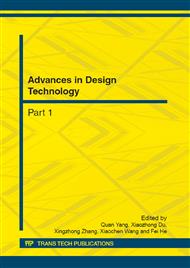p.225
p.229
p.235
p.239
p.244
p.249
p.254
p.258
p.263
Research on Verfiable Design Model for Design Defect of Mechanical Assembly
Abstract:
Final assembly deviations of mechanical products are determined by accumulation, coupling and propagation of all parts tolerances in the assembly system, whether the final assembly meets the design specification or not can only be obtained after the assembly is completed. The verifiable design model in this paper took object-oriented Petri net as logic lever carrier, and embedded deviation in form of matrix to Petri net, and then analyzed and calculated the assembly deviation from the logical and numerical lever synchronically, after that the final cumulative deviation is obtained. If the cumulative deviation exceeded precision limit, key influence factors to the cumulative deviation could be analyzed. The assembly design defect is identified and located in the design process, and the synchronization of design and verification is achieved. This model has some excellent characteristics, such as modularization, reusability, and capability to describe structural logical relationships.
Info:
Periodical:
Pages:
244-248
Citation:
Online since:
November 2012
Authors:
Price:
Сopyright:
© 2012 Trans Tech Publications Ltd. All Rights Reserved
Share:
Citation:


